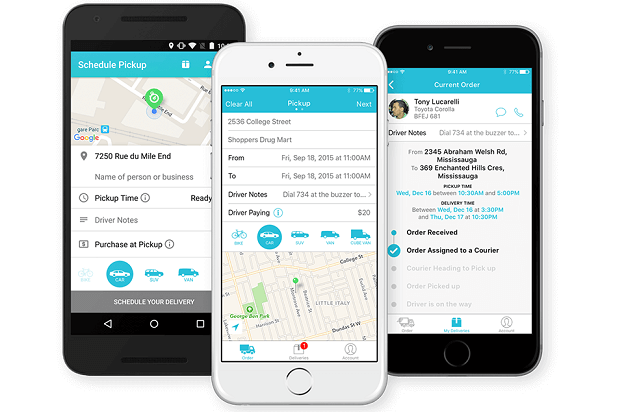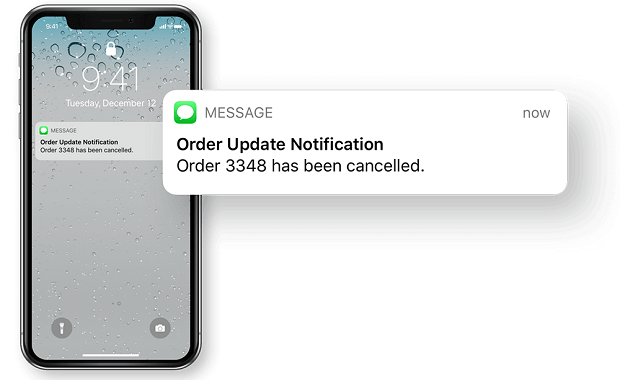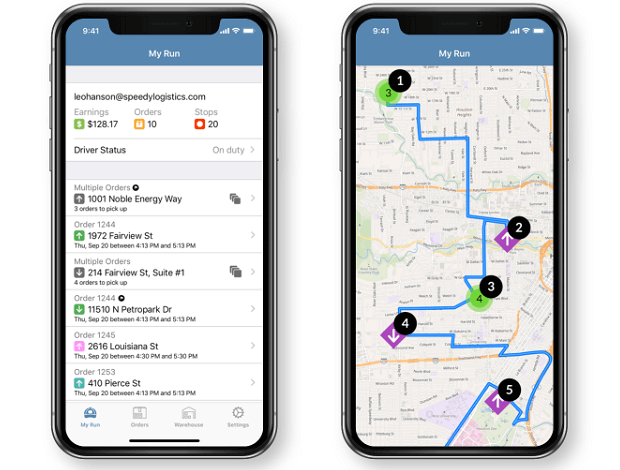Below is our recent interview with Arthur Axelrad, Co-Founder of Dispatch Science:
Q: What is Dispatch Science?
A: We are an all-in-one delivery management system that harnesses the power of artificial intelligence to automate complex tasks for delivery and field service companies.
Our software, coupled with the GPS positioning of smartphones and the power of cloud computing, automates manual coordination, dispatching and routing activities for on-demand and last-mile delivery providers. It improves on the critical capabilities courier operators count on from their management systems.
Since we got our start as mobile app developers, our solution has been developed as a mobile-first with no-compromise user experience and near-perfect mobile tracking capabilities
 Recommended: Quiq Raises 12.5 Million In Series B To Help Companies Orchestrate Commerce And Service Conversations
Recommended: Quiq Raises 12.5 Million In Series B To Help Companies Orchestrate Commerce And Service Conversations
Q: Where is Dispatch Science positioned in the current industry environment?
A: Many current providers offer mature technology and tools that weren’t designed to leverage the elasticity of the cloud, nor utilize algorithms to automate complex tasks. We offer a modern alternative that can decouple high-volume order/service businesses from the manual operations causing their bottlenecks.
Furthermore, the demand is increasing from e-commerce giants like Amazon, Walmart, and others to offer same-day deliveries. To meet these demands, the fragmented delivery industry must update their legacy systems, implement electronic order capture, offer real-time order tracking with previously unheard-of levels of transparency.
This is where we come in. Dispatch Science is a smart delivery solution that uses the power of artificial intelligence, cloud computing, smartphones, and mapping services. The system provides intelligent support for routing and dispatching while adhering to every combination of pricing, service level, zone rules, and other delivery logistics factors required for a delivery business. It’s a challenge that older dispatching systems can’t match.
Q:What makes Dispatch Science different from other delivery management systems?
A: Our proprietary algorithms use artificial intelligence to automate the order dispatching process. Our system effectively evaluates every possible scenario to propose the best routes and order-to- driver assignments that will minimize overall lateness and least travel distances. Dispatching can become semi- to fully automatic. Business rules further ensure the appropriate vehicle decisions can be based on established business rules to identify the best driver and vehicle and match these to the route based on service level (SLA) agreements.
Q: How does the system work?
A: Delivery orders are pre-sorted based on common criteria. Our optimization algorithms then evaluate the on-time delivery and travel distances of most combinations of order-to-driver assignments. The overall model that results in least lateness and least distance is retained. Drivers receive their assigned orders on their smartphones, and they can easily accept or pass on orders. It’s basically an Uber-style app for couriers, except we can assign entire routes, not just one order at a time. The algorithm continuously reruns to adjust to new orders, cancellations, driver delays, and other real-world events.
Dispatch Science also optimizes loading and routing so vehicles can be packed on a first-in and last-out basis, to minimize the time drivers spend at each stop. That means delivery routes are dynamically created to best match the carriers’ business objectives: stop density, workload balancing and driver earnings, to name a few. We can send alerts with the latest delivery estimate to drivers, dispatchers, customers, and final recipients.
Q: How does the system help dispatchers streamline their workflow?
A: Dispatchers have more control with management tools that enable them to track, rank and solve exception issues. Their specialized competencies are put to better use, increasing customer satisfaction and driver performance. This increased focus on core competencies saves operating costs and improves profitability margins.
Q: What types of companies can benefit from this software?
A: Our algorithms are flexible enough to help companies in many sectors. It will be a competitive advantage for any company that dispatches field personnel with on-demand or fixed routes such as couriers, parcel delivery companies, last-mile deliveries, pharmacy deliveries, prepared food and meal kits and other specialized deliveries. We’re also starting to work with companies engaged in white-glove deliveries, which involve complicated deliveries requiring tool inventory, sophisticated workflows, and replenishment kits. We’re now poised for success with field service organizations of all kinds.
 Recommended: An Interview With Jana Dybinski, VP Marketing And Culture At Rebel.com
Recommended: An Interview With Jana Dybinski, VP Marketing And Culture At Rebel.com
Q: How does the system optimize deliveries?
A: The most critical part of on-demand deliveries for small parcel delivery is route optimization. Dispatch Science optimizes driver routes for best performance and shortest route distances, ensuring the highest stop density without any human intervention.
Q: Why do customers choose your solution over others in the marketplace?
A: We address today’s customer expectations by offering “Uber” levels of transparency into their deliveries. They have the ability to know where the shipment is at any time and when it will arrive, all the while receiving updates and alerts for any changes.
Our customers are facing tremendous pressure to process more deliveries at lower prices. This margin pressure makes it unrealistic to compete if human intervention is required to handle every order. We use automation to transform dispatchers into exception managers, able to oversee daily activities and focus on problem-solving and coordination when needed.
Also, our clients appreciate that our solution extends delivery process visibility and alerts to their customer’s customers. Combined with our API integration, we help our clients tightly and seamlessly integrate into their shippers’ supply chains, thus making them collaborative partners rather than easily replaceable suppliers.
Q: How do your underlying technologies work?
A: Behind the scenes, we use smart APIs, integrated mapping services for real-time geocoding, locations services and true elastic cloud processes.
Our purpose-built algorithm continuously processes demand data, which includes all the information surrounding an order: what, how many, pickup location, delivery location and time, delivery authorization, communications preferences, and so on. The algorithm looks at all the information and builds a possibility matrix.
The possibility matrix connects to a route optimization engine that scores or rates the possibilities. Finally, the optimizer continuously filters the possibilities matrix for the best solution. The result of that process is sent to the driver’s mobile app in the form of an optimized stop list.
Building from the stop list, the automated dispatch feature, coupled with optimized dynamic routing, enables a delivery business to simplify the complexity of their operations and eliminate errors with the potential of increasing volume without increasing staff.
The Optimizer feature evaluates a driver’s entire workload, the due times for each pickup and delivery, and current and future position of each driver. It automatically assigns orders to the best driver for optimal time and distance efficiency while it maximizes delivery capacity, all while ensuring customer requirements are met. It optimizes driver routes for best performance and shortest route distances with highest stop density. Drivers can make more deliveries but complete their routes in the shortest amount of time and miles possible.
All that data is processed using the elastic scalability of the cloud. Server memory, CPU’s, and disks are automatically allocated to match actual requirements at any given time.
Q: Will automated dispatching reduce headcount?
A: The objective is to reduce manual processes and give companies the ability to allocate their labor resources where they’re most needed. Dispatch Science helps companies eliminate manual processes. Companies can repurpose staff to focus on higher-value work and execute their workload with better operating efficiencies. This way, they can increase their order volume and maximize their drivers’ capacity without increasing administrative costs.
Drivers hate wasting time. Dispatch Science lets drivers squeeze the most deliveries into their days, while providing optimized routes with the highest stop density possible. What’s more, tools like real-time notifications and digital proof of delivery end paperwork hassles.
With automated dispatching, dispatchers can transition from manual communications and decision-making to using tools to automate routine. They can spend more time on customer and driver relations. Dispatchers won’t need to be replaced; they’ll be more productive and able to keep up with business growth.
 Recommended: An Interview With Daniel Casey, CEO Of Genii-Systems
Recommended: An Interview With Daniel Casey, CEO Of Genii-Systems
Q: Why should companies take the risk to switch systems?
A: Switching to Dispatch Science delivers immediate ROI, reducing margin erosion and operating costs. Drivers will have the tools to make the most deliveries in the fewest miles and maximize their potential. The tools can help solve driver recruitment and retention challenges by providing visibility into driver earnings. Users can elevate their customer experience to a whole new level with shipment transparency and real-time tracking available through the app. Customers will be able to interact with your company at their convenience, which helps in attracting and retaining customers.
Q: What does the future hold for Dispatch Science?
A: With the growth of same-day, four-hour, two-hour or even one-hour deliveries, we’re seeing last-mile and retail deliveries suddenly taking-on the characteristics of the traditional on-demand model. We’re building the capability to predict those delivery volumes based on historical data. We’ll track the periods in which businesses see higher demand due to customer preferences or seasonal needs. We will help companies plan their resources, so drivers are available in geographic areas to meet predicted demands.
Beyond that, the next frontier will be automated dispatching of autonomous vehicles. That’s a few years away obviously, but when the vehicles will be ready, so will we.

